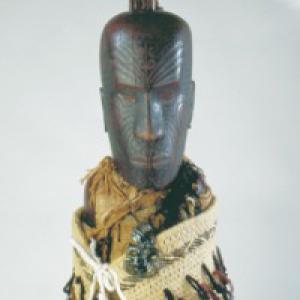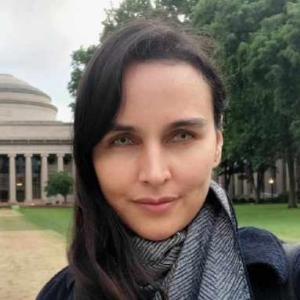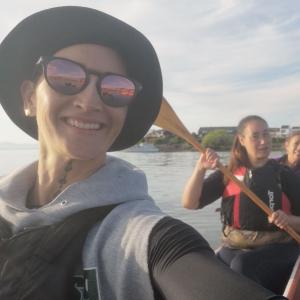He aha te mea te taonga? Ko te taonga he mea ka tū hei tuakiri mō te whānau, hapū, iwi rānei me ō rātou whenua tipu.
What exactly are taonga? A taonga can be any item, object or thing that represents the ancestral identity of a Māori kin group (whānau, hapū or iwi) in relation to particular lands and resources.
Ka taea e koe te tā i te taonga pērā ki ngā momo kākahu, ki ngā patu pounamu, me tētehi waka tauā rānei. Arā hoki ētahi kāore koe e āhei ana ki te tā, pērā ki te mātauranga ki te mahi whakairo, ki te taki whakapapa me te waiata mōteatea rānei.
Taonga can be tangible like a cloak, a greenstone weapon or a war canoe, or they can be intangible like the knowledge to be able to carve, recite geneaology or sing a lament.
Ina ka heke iho ngā taonga ki ia rēanga ka whakataumaha hoki te mana ki runga.
As taonga are passed down through the generations they become more valuable as the number of descendants increases.
Kei ia taonga te mana, te tapu me te kōrero. Mehemea he tino rangatira te kaipupuri o tētahi taonga he nui hoki te mana o ana taonga.
All taonga possess, in varying degrees, the elements of mana (ancestral prestige), tapu (spiritual protection) and kōrero (genealogically ordered narratives). The greater the ancestors, the greater the mana of associated taonga.
Mā ngā karakia ka tiaki i te tapu o ngā taonga kia tau pai ai ki runga i te mata o te whenua mō ake tonu
Taonga are protected through karakia (rituals and incantation), which invoke the element of tapu and ensure they are treated with due reverence.
Mā nga taonga anōka mau ai i te wairua o tētahi tūpuna, arā, ko te taonga te tangata, ko te taonga. Mā te wairua o ngā taonga ka puta tōna ihi, te wehi, me te wana.
They are seen as the spiritual personifications of particular ancestors, either as direct images or through association. Descendants experience this wairua (ancestral spirit) as ihi (presence), wehi (awe) and wana (authority).
Nō reira, ka heke iho ngā taonga mai rā anō, ā, tae atu ki ngā rā ka whai ake kia āhei ia rēanga ki te tūtaki i o rātou tūpuna, kanohi ki te kanohi.
Thus taonga are time travellers, bridging the generations, allowing descendants to meet their ancestors ritually, face to face.
Āpiti atu i tēnā, ko ngā taonga hei tauheretia i ngā rēanga ki ngā rā o mua. Mā ngā taonga ka whakamārama ake i te whakapapa ā-tangata, ā-whenua hoki.
Furthermore, taonga are vital threads from the past, acting as guides to interpreting the past. They assist descendants to understand the often complex whakapapa (genealogical relationships) that remain patterned across whenua (ancestral lands) of modern tribal New Zealand.
I roto i ngā tangihanga ka kitea mārama ai e koe ngā tikanga ka tau e ngā koroua hei whakatō i ngā tūpuna kia kawe atu i te tūpāpaku ki Hawaiki.
This is most apparent during tangihanga, when taonga are ‘performed’ by descendant elders on marae (ritual courtyards), summoning appropriate ancestors from Hawaiki, the Maori spiritual homeland, so they might collect the newly deceased and take him or her home.
Pērā te mahi rapu kōrero mō ngā taonga ki te whai atu i tētahi aho a te korowai.
Tracking the pathway of taonga through the Maori universe of time and space is like tracing an aho (a single thread) in a korowai (cloak).
He rite tonu te rere o te aho ki te rere o te tūī te ngahere, arā, ka puta, ka huna, ka puta, ka huna anō. Ka haere pēnei, ā, ka tāpiri ki ētahi atu aho, taonga rānei, ka heke iho mai i tētahi rēanga whakapapa ki te mea e whai ake.
The aho, like the flight of the tui through the bush, appears and disappears, time after time, in a repeating pattern that interlocks with other threads, or taonga, descending from one layer of whakapapa to the next.
This is an excerpt from the bi-lingual book Ko Tawa - Māori Treasures of New Zealand, written and published in 2006 by University of Otago academic and NPM Principal Investigator Professor Paul Tapsell.
Books too are taonga and here at NPM this 2017 Te Wiki o Te Reo Māori, we will be acknowledging the work of Māori researchers and writers in publishing books that celebrate and acknowledge the importance of te reo, tikanga and mātauranga for our future wellbeing and understanding of Te Ao Māori and its importance to all of our futures.

He Kōrero | Our Stories
Neuroscientist Nicole Edwards is establishing her own lab at the University of Auckland and is eager to tautoko students interested in a career in brain research.
AUT senior lecturer Deborah Heke encourages wāhine Māori to cherish their connection with te taiao.
Tairāwhiti local Manu Caddie is a vocal critic of forestry companies engaged in unsustainable land practices in the rohe. He shares his insights on what needs to change".


